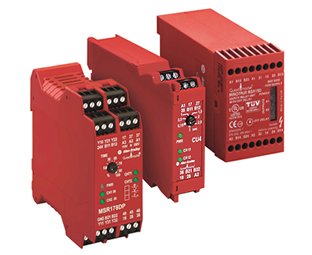
Safety First! – MSR vs GSR Safety Relays – Hardware Comparison
In today’s manufacturing environments, few companies can remain competitive without extensive industrial automation. Automation speeds processes, reduces errors, enables precision manufacturing, and provides system-wide control. Critically, it also reduces operator fatigue by eliminating repetitive manual tasks, improving safety and overall quality.
Equally important to the automation functions are the safety features embedded within the control systems. These features, created through dedicated safety circuits, are designed to protect operators and technicians from injury while safeguarding capital equipment and minimizing material waste due to malfunctions. Safety relays are at the heart of these circuits, acting as vigilant watchdogs within every control panel.
Safety relays function in tandem with programmable logic controllers (PLCs), sending critical commands to mechanical components to halt or alter operation when unsafe conditions arise. Common functions include:
-
Emergency stops (E-Stops)
-
Gate, valve, or door interlock control
-
Shutdowns during guard removal or disruption
-
Controlled depowering to prevent hazardous machine behavior
Devices enabled through safety relays include:
-
Light Curtains – Breaks in the light beam initiate a stop.
-
Safety Mats – Triggered by pressure or overload presence.
-
Two-Hand Controls – Ensure both hands are in a safe zone during operation.
-
Magnetic Switches – Manage closure integrity of gates and covers.
-
Interlock Safety Switches – Ensure sequence conditions are met before mechanical access.
Allen-Bradley offers two main safety relay families: the MSR (Minotaur Safety Relay) and the GSR (Guardmaster Safety Relay). While both are trusted solutions, the GSR series introduces expanded capabilities and modernized features that are optimized for current automation demands.
1. Size & Footprint
-
MSR relays require 45 mm to 90 mm of DIN rail space.
-
GSR relays are more compact: 22.5 mm for standard modules and 45 mm for higher-capacity models.
-
This reduced footprint frees up space in crowded control panels.
2. Response Time
-
MSR modules often provide single-function, low-latency responses.
-
GSR modules have configurable safety functions. Some offer faster response, while others match MSR timings depending on configuration and function.
3. Load Capacity
-
GSR modules generally draw less or equivalent DC load current compared to MSRs.
-
Lower thermal dissipation under non-switching loads enhances reliability and lifespan.
4. Channel Input & Diagnostics
-
MSR uses separate hot/common input channels for diagnostics.
-
GSR uses pulsed voltage on both inputs, enabling:
-
Detection of cross-channel shorts
-
Identification of open circuits
-
Overriding voltage error checks
-
Simplified wiring and advanced diagnostics
-
5. Connectivity & Scalability
-
MSR relays support single-function safety circuits and require one relay per function.
-
GSR relays utilize Single-Wire Safety (SWS) interconnection, allowing daisy-chaining and expansion across multiple relays.
6. Configuration & Flexibility
-
GSR modules are configurable, handling multiple safety functions and supporting consolidated safety circuits.
-
This consolidation reduces parts count, wiring complexity, and installation time.
7. Compliance
-
GSR relays meet RoHS standards, aligning with global regulations (especially within CE-marked EU regions).
-
MSR modules, as legacy models, do not all meet modern environmental or regulatory requirements.
-
MSR Safety Relays are dependable, simple, and ideal for applications requiring straightforward, dedicated safety functions. Their fixed logic offers fast reaction but minimal adaptability.
-
GSR Safety Relays are suited for modern, dynamic systems needing modularity, detailed diagnostics, and scalable integration. Their configurable logic and advanced communication make them the preferred choice for Industry 4.0 systems.
While GSR units are not designed as direct 1:1 replacements for MSR relays, they offer broader applicability and the flexibility required for rapidly evolving manufacturing environments. With their improved communication protocols, modular design, and compliance with safety standards, GSRs are purpose-built for smart manufacturing systems.
Whether you're updating legacy equipment or designing a new automation line, the choice between MSR and GSR relays comes down to complexity, functionality, and compliance requirements. Safety should never be an afterthought—and selecting the right relay system ensures both protection and productivity.
PLG Automation is here to help. Contact us to source MSR or GSR relays and determine the best-fit safety solution for your operation.
PLG Automation
sales@plgautomation.com
800-906-9271
